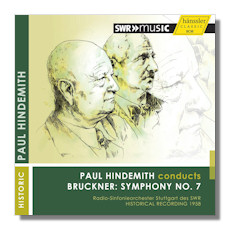
The Internet's Premier Classical Music Source
Related Links
- Bruckner Reviews
- Latest Reviews
- More Reviews
-
By Composer
-
Collections
DVD & Blu-ray
Books
Concert Reviews
Articles/Interviews
Software
Audio
Search Amazon
Recommended Links
Site News
 CD Review
CD Review
Anton Bruckner

Symphony #7
Southwest German Radio Symphony Orchestra, Stuttgart/Paul Hindemith
Live radio broadcast (24 June 1958)
Hänssler Classic 94.222
The celebrated composer Paul Hindemith was no stranger to the conductor's podium, to which he turned increasingly after World War II as his solo career as a violist wound down. The existing studio recordings are primarily of his own compositions, but he was more wide-ranging in the concert hall and on radio broadcasts. Recordings exist of three complete Bruckner symphonies – one of the Third in the 1889 version and two of the Seventh in the 1885 Guttman edition. This recording is the earliest of the two Sevenths, dating from 1958 while the other is with the New York Philharmonic in 1960.
There are some parallels between Hindemith and Bruckner – both were deeply attached to the great contrapuntal tradition and somewhat out of step with the music of their times. Admittedly, Hindemith's talent fell far short of Bruckner's, and he was much more successful than Bruckner in his own lifetime. But still it is an intriguing match.
Like most conductors of the time Hindemith was deeply influenced by Furtwängler. He displays much greater rhythmic flexibility than we are used to nowadays, unashamedly in the service of a very dramatic and romantic approach to the symphony.
This performance has one very interesting structural feature – the first and second movements have almost exactly the same duration, whereas in the vast majority of performances the second movement is significantly longer than the first. Karl Böhm's famous 1943 performance with the Vienna Philharmonic has the two movements coming in at 18'43" and 26'37" respectively. For Hindemith the timings are 18'45" and 18'53" respectively.
One consequence of this architecture is that the Adagio does not overwhelm the other movements, as it is only too easy to do. Instead Hindemith is able to set an exciting mood and pace in the first movement and carry it through to the end, while still allowing the second movement to serve as the symphony's spiritual heart and center of gravity.
The music-making is a little rough around the edges. The horns go uncomfortably awry every once in a while and there is occasional ragged playing in the wind section. But the strong, rich string sound carries the day. The two words that best characterize this performance are "exciting" and "momentum". It is of far more than historical interest and the sound quality is a pleasant surprise.
Copyright © 2014, José Luis Bermúdez




















